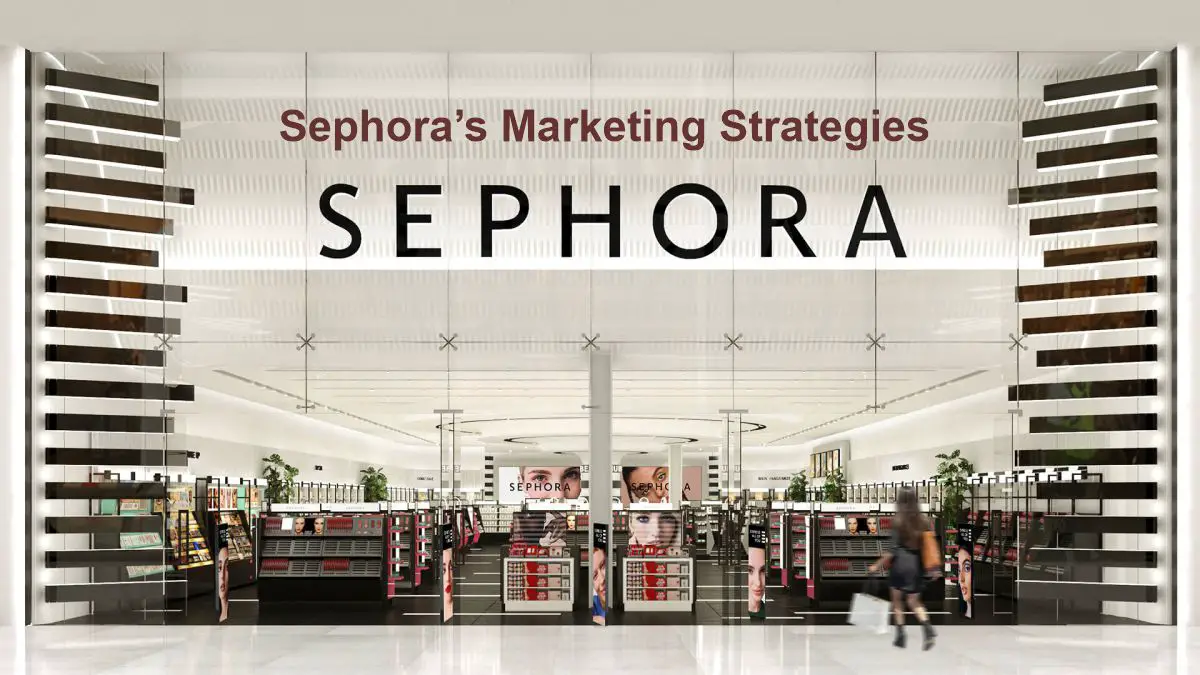Sephora isn’t just another beauty retailer—it’s a global powerhouse that has mastered the art of connecting with diverse customer segments through creative, data-driven, and inclusive marketing. Whether it’s their in-store experiences, loyalty programs, or influencer-led campaigns, Sephora consistently finds innovative ways to capture attention and build lasting brand loyalty.
With over 2,700 stores worldwide, 34 million+ Beauty Insider members, and digital channels driving nearly 30% of sales, Sephora’s marketing is a masterclass in blending tradition with technology.
This guide breaks down the core elements of Sephora’s marketing success, from their marketing mix and target audience to specific strategies across traditional, digital, and social media channels—plus the lessons any business can learn from them.
Sephora’s Marketing Mix in a Nutshell
Sephora’s domination of the beauty industry is no accident—it’s the result of a well-balanced 4Ps strategy (Product, Price, Place, Promotion).
1. Product
Sephora caters to every beauty shopper—from those seeking luxury names like Dior, Chanel, and Estée Lauder to budget-conscious consumers through their Sephora Collection. Their assortment spans makeup, skincare, fragrance, haircare, and beauty tools.
2. Price
Sephora strikes a rare balance: they stock premium products for high-spending beauty lovers while also offering mid-range and affordable picks. This dual pricing strategy ensures accessibility without diluting their upscale image.
3. Place
With over 2,700 brick-and-mortar locations worldwide and a robust e-commerce presence (website + mobile app), Sephora ensures convenience. Their online store is intuitive, personalized, and seamlessly connected to their loyalty program.
4. Promotion
Sephora uses an integrated promotion approach that blends paid advertising, influencer collaborations, user-generated content, email campaigns, and in-store events. They also leverage loyalty perks and data-driven recommendations to keep customers engaged.
Sephora’s Target Audience Analysis
Sephora’s customers primarily fall into two key generations—Millennials and Gen Z—but their marketing effectively resonates across age groups.
- Millennials (27–42): Value convenience, are loyal to brands they trust, and appreciate rewards programs. They often have higher disposable incomes and shop both online and in-store.
- Gen Z (11–26): Digital-first shoppers heavily influenced by TikTok, Instagram, and influencer culture. They seek authenticity, inclusivity, and sustainable practices.
Sephora appeals to both through:
- Inclusivity & diversity: Campaigns like We Belong to Something Beautiful ensure representation of all genders, skin tones, and body types. They pledged 15% shelf space to Black-owned brands.
- Digital innovation: Tools like the Virtual Artist AR app allow customers to “try on” products virtually.
- Eco-conscious initiatives: Their Clean at Sephora label helps identify products made without certain harmful ingredients.
SWOT Analysis of Sephora
Strengths
- Strong, consistent brand image.
- Immersive in-store experiences.
- Extensive product range.
- Highly interactive e-commerce platform.
Weaknesses
- Higher prices may alienate budget shoppers.
- Limited presence in some emerging markets.
- “Showrooming” effect—customers try in-store, buy elsewhere.
- Heavy reliance on premium pricing.
Opportunities
- Expand private label products.
- Grow presence in untapped global markets.
- Enhance sustainability practices.
- Increase experiential retail offerings.
Threats
- Competition from Amazon and direct-to-consumer beauty brands.
- Counterfeit product risks.
- Over-reliance on influencer marketing.
- Economic downturns affecting discretionary spending.
Sephora’s Marketing Strategies Across Channels
Sephora’s marketing is multi-dimensional, blending traditional retail tactics, social media engagement, and data-driven digital marketing.
1. Traditional Advertising & Retail Experiences

Immersive Stores
Sephora’s flagship stores—like the iconic Champs-Élysées location in Paris—are designed to be more than shopping destinations. They offer:
- Personalized consultations.
- Exclusive product launches.
- Interactive testing stations.
- Luxury brand corners.
Events & Pop-Ups
Their SEPHORiA: House of Beauty event brings the brand to life with:
- Influencer meet-and-greets.
- Interactive installations.
- Hands-on product experiences.
- Exclusive launches.
Print & Outdoor Ads
Sephora uses billboards, magazine features, and high-traffic outdoor placements (like Times Square) to reinforce inclusivity and showcase campaigns.
Loyalty Program
The Beauty Insider Program is a tiered rewards system offering:
- Discounts.
- Birthday gifts.
- Early sale access.
- Free samples.
With millions of members, it’s one of the strongest retention tools in retail.
2. Social Media Marketing Strategy
Sephora’s social presence is huge:
- Instagram: 22M+ followers.
- TikTok: 1.7M+ followers.
Influencer Collaborations
The Sephora Squad features diverse creators producing tutorials, reviews, and authentic content.
User-Generated Content
Hashtags like #SephoraHaul encourage customers to share their purchases, fueling organic reach.
Interactive Campaigns
Social challenges, polls, and giveaways boost engagement while reinforcing community.
3. Digital Marketing Strategy
Community Building
The Beauty Insider Community lets shoppers connect, share tips, and post reviews, fostering brand advocacy.
Paid Advertising
PPC campaigns on Google, Facebook, and Instagram use short-form videos, carousel ads, and targeted copy to drive conversions.
Personalization & AI Tools
- Color IQ: Matches foundation shades.
- Skin IQ: Creates custom skincare routines.
- AR Try-On Tools: Lets users virtually test makeup.
Key Lessons Businesses Can Learn from Sephora
- Know your audience—tailor every campaign to their values.
- Make shopping an experience—turn stores into destinations.
- Build community, not just customer lists—foster connections between shoppers.
- Blend traditional & digital—ensure consistent messaging across channels.
- Personalization matters—use data to recommend, not push.
- Authenticity beats perfection—feature real people and real stories.
- Reward loyalty meaningfully—offer perks customers truly value.
Deep Dive: Sephora Campaigns That Changed the Game
To truly understand Sephora’s marketing mastery, let’s break down a few of their most notable campaigns and how they resonated with different audience segments.
1. “We Belong to Something Beautiful” Campaign
- Goal: Strengthen brand values around inclusivity, diversity, and belonging.
- Execution: Featured real people from all walks of life—different ethnicities, genders, ages, and body types—in both video and print ads.
- Why It Worked: It wasn’t just marketing—it was a statement of identity for Sephora. It resonated deeply with Gen Z and Millennials who expect brands to stand for something.
2. The Sephora Squad Influencer Program
- Goal: Build long-term, authentic influencer relationships.
- Execution: Instead of one-off sponsored posts, Sephora recruits creators annually to become brand ambassadors, providing training, exclusive previews, and collaborative content opportunities.
- Why It Worked: This “community of influencers” model ensures ongoing, organic promotion and taps into the trust influencers have with their followers.
3. Virtual Artist AR App
- Goal: Merge beauty retail with digital convenience.
- Execution: Users can test lipstick, eyeshadow, and foundation shades on their phone using augmented reality.
- Why It Worked: It solved a pain point—shopping for beauty products online without trying them on—and increased conversion rates on digital channels.
4. SEPHORiA: House of Beauty
- Goal: Make Sephora events as anticipated as product launches.
- Execution: Interactive beauty playgrounds with product demos, classes, meet-and-greets, and exclusive releases.
- Why It Worked: It turned Sephora into an experience brand—not just a store—and created endless UGC for social media.
5. Clean at Sephora
- Goal: Meet the growing demand for clean, non-toxic beauty.
- Execution: A curated product category labeled with clear “Clean at Sephora” tags, both online and in-store.
- Why It Worked: It built trust and transparency, aligning with eco-conscious values that are especially important to younger shoppers.
Data-Driven Personalization: Sephora’s Secret Weapon
One of Sephora’s competitive advantages is how they use data analytics to make the shopping experience feel custom-tailored. Here’s how they do it:
- Behavior Tracking: Browsing and purchase history guide product recommendations.
- AI-Powered Matching: Tools like Color IQ and Skin IQ take the guesswork out of beauty.
- Email Personalization: Rather than generic promos, customers get targeted emails featuring items in their preferred shade ranges, skin type matches, or brands they’ve shown interest in.
- Loyalty Data Utilization: Sephora knows exactly what perks and promotions encourage repeat visits based on loyalty member behavior.
How Sephora Balances Global & Local Marketing
Sephora operates in over 30 countries, but they don’t just copy-paste campaigns—they adapt to each region.
- In the U.S.: Heavy focus on inclusivity, influencer partnerships, and sustainability.
- In Europe: Strong emphasis on luxury branding and exclusive launches.
- In Asia: Increased attention to skincare and K-beauty trends, plus partnerships with local celebrities.
- Localized Social Content: Instagram posts in each country highlight local beauty influencers, events, and product availability.
This “glocal” (global + local) strategy ensures Sephora stays relevant while maintaining a consistent brand identity.
Why Sephora’s Loyalty Program is Marketing Gold
Many brands have loyalty programs, but Sephora’s Beauty Insider is in a league of its own because it:
- Rewards real behavior: The more you spend, the more valuable the rewards.
- Offers experiential perks: Early access to products, exclusive events, and beauty classes.
- Encourages community: Members feel part of an exclusive beauty club.
- Generates data: Every purchase adds to Sephora’s customer insights.
This loyalty program alone is responsible for millions of repeat transactions annually.
Sephora’s Digital Edge Over Competitors
While Ulta Beauty, Nordstrom, and others compete in the same space, Sephora consistently edges ahead digitally. Here’s why:
- Superior Mobile App Experience: Easy navigation, virtual try-ons, and personalized shopping.
- Content Marketing: Tutorials, how-to videos, and shoppable beauty blogs.
- SEO Dominance: Ranking for thousands of product-related keywords.
- Seamless Omnichannel Experience: Buy online, pick up in-store; same loyalty perks online and offline.
Challenges Sephora Must Overcome
Even a leader like Sephora faces hurdles:
- Price Sensitivity: Competing against affordable direct-to-consumer beauty brands.
- Counterfeit Products: Risk on marketplaces like Amazon damaging brand trust.
- Economic Pressures: Inflation could shift spending to cheaper alternatives.
- Influencer Market Saturation: Risk of influencer fatigue if partnerships feel inauthentic.
Addressing these challenges will be crucial for Sephora’s continued dominance.
FAQs: Sephora’s Marketing Strategy
1. What is Sephora’s primary marketing approach?
A blend of experiential retail, influencer marketing, digital personalization, and inclusive branding.
2. How does Sephora use social media effectively?
Through Sephora Squad influencers, UGC campaigns like #SephoraHaul, and platform-specific strategies (TikTok challenges, Instagram Reels, YouTube tutorials).
3. Why is Sephora’s loyalty program so successful?
Because it offers tiered, meaningful rewards, builds a sense of belonging, and integrates seamlessly into both online and offline shopping.
4. How does Sephora appeal to Gen Z shoppers?
By prioritizing authenticity, diversity, sustainability, and digital-first experiences like AR try-ons.
5. What makes Sephora different from Ulta or department stores?
Its luxury-meets-accessible product mix, cutting-edge personalization technology, and unmatched community engagement.
Key Takeaways for Businesses
- Integrate values into marketing—Don’t just sell products, sell beliefs.
- Leverage technology to personalize—AI and AR tools create an interactive experience.
- Use influencers as partners, not ads—Long-term collaborations feel authentic.
- Create unforgettable experiences—Events and in-store experiences strengthen emotional ties.
- Adapt globally, think locally—Tailor marketing to each market’s unique trends and values.
Final Thoughts
Sephora’s marketing success lies in balance—balancing luxury and affordability, online and offline, technology and human connection. They’ve proven that in the beauty industry, selling products is just the beginning; selling experiences, values, and belonging is what creates a loyal global community.
Businesses in any sector can take inspiration from Sephora’s approach—listen to your customers, adapt to their needs, and create an experience they’ll want to return to again and again.

